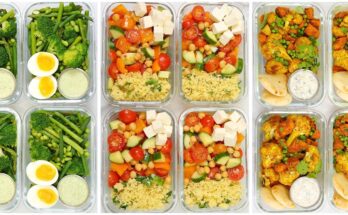Korean Rice Cake Recipe: Korean rice cake, known as “Tteok”, is more than just a snack or dessert—it’s a dish deeply rooted in Korean tradition and culture. Whether served during celebrations, ancestral rites, or simply enjoyed as a treat, rice cakes are an essential part of Korean cuisine. Their chewy texture, mild sweetness, and versatility make them a favorite among both locals and international food lovers.
In this detailed guide, you’ll learn everything you need to know about making Korean rice cakes from scratch. From the essential ingredients to the step-by-step process, we’ll break it all down so you can confidently create this delicious dish at home.
What is Tteok?
Tteok refers to a wide variety of Korean rice cakes made from glutinous rice flour (chapssal garu) or regular rice flour (ssal garu). Unlike Western cakes that rely on baking, Korean rice cakes are usually steamed, pounded, or boiled, giving them a chewy, sticky consistency that is both unique and satisfying.
Depending on the type, tteok can be plain, filled, or coated with various toppings like sesame seeds, soybean powder, or even sweet red bean paste. The texture ranges from soft and chewy to firm and dense, making it suitable for both savory and sweet dishes.
Cultural Importance of Korean Rice Cake
Rice cakes have been a symbol of good fortune, prosperity, and health in Korean culture for centuries. Traditionally, they are served during birthdays, weddings, ancestral ceremonies, and especially Chuseok (Korean Thanksgiving) and Seollal (Lunar New Year).
Different types of rice cakes hold different meanings. For example:
- Songpyeon (half-moon rice cake) is made during Chuseok to symbolize abundance and blessings.
- Garaetteok (long cylindrical rice cake) is eaten on New Year’s Day in tteokguk (rice cake soup), symbolizing long life.
So, when you make rice cakes at home, you’re not just cooking—you’re carrying forward a tradition that has been cherished for generations.
Ingredients You’ll Need for Korean Rice Cake
Before you begin, gather the right ingredients and tools. Rice cakes may look simple, but the key to achieving that perfect chewy texture lies in the quality of ingredients and steaming process.
Core Ingredients (Rice Flour, Salt, Sugar)
- Glutinous Rice Flour (Chapssal Garu): The main ingredient that gives rice cakes their signature sticky texture.
- Regular Rice Flour (Ssal Garu): Sometimes combined with glutinous rice flour for a firmer consistency.
- Salt: A pinch helps balance sweetness and enhance flavor.
- Sugar: Optional, depending on whether you want a sweet rice cake or a plain base for savory use.
Optional Flavorings and Fillings
Want to customize your rice cakes? Here are some common add-ins:
- Sweetened Red Bean Paste (Pat): For a rich, sweet filling.
- Roasted Soybean Powder (Kinako/Chalbori Garu): Used as a coating for chewy rice cakes.
- Sesame Seeds or Sesame Oil: Adds nuttiness.
- Nuts & Dried Fruits: Walnuts, chestnuts, or jujube (Korean dates) are popular in traditional recipes.
Equipment and Tools Needed
- Steamer or Steamer Basket: Essential for cooking rice cakes.
- Mixing Bowl & Sieve: For combining and sifting flour.
- Cheesecloth or Steamer Cloth: Prevents rice cakes from sticking.
- Mortar & Pestle (Optional): Traditional pounding method for chewy varieties.
- Sharp Knife or Kitchen Scissors: For cutting rice cakes into shapes.
Step-by-Step Guide to Making Korean Rice Cake
Now that you have everything ready, let’s get into the actual cooking process. While there are many variations of tteok, this guide will cover the basic steamed rice cake recipe, which you can adapt to different styles later.
Step 1 – Preparing the Rice Flour
If you’re starting with packaged rice flour, sift it through a fine mesh sieve to break up any clumps. If you want to go traditional, soak short-grain rice overnight, drain, and grind it into fine flour using a high-powered blender or grain mill.
Moisture control is crucial—too much water, and your rice cake will be sticky and soggy; too little, and it will turn out crumbly and dry. The flour should feel slightly damp when squeezed, forming a soft clump that easily breaks apart.
Step 2 – Mixing the Ingredients
Transfer your rice flour to a large mixing bowl. Add a pinch of salt and a few tablespoons of sugar if you’re making a sweet version. Gradually sprinkle water over the flour while mixing with your hands. The mixture should resemble wet sand—moist enough to clump together but not overly wet.
If adding flavorings or fillings, this is the stage to fold them in. For filled rice cakes, you’ll assemble them later after steaming.
Step 3 – Steaming the Rice Cake
Line your steamer with cheesecloth or parchment paper. Spread the prepared rice flour mixture evenly into the steamer basket, pressing gently but not too firmly (overpacking leads to dense rice cakes).
Steam over medium-high heat for 20–30 minutes until the rice flour mixture turns translucent and firm. Resist the urge to open the lid too often, as this can release steam and disrupt cooking.
Step 4 – Cooling and Shaping the Rice Cake
Once cooked, let the rice cake rest for 5–10 minutes before handling. Carefully remove it from the steamer, then transfer it to a clean surface dusted with cornstarch or soybean flour to prevent sticking.
Cut into squares, rectangles, or use molds for fun shapes. For filled varieties, wrap dough pieces around fillings like red bean paste before shaping.
Step 5 – Serving and Storing Rice Cake
Fresh rice cakes are best enjoyed warm, when they’re at their softest and chewiest. However, they can also be cooled and coated with soybean powder or sesame seeds for extra flavor.
If not eating right away, wrap rice cakes tightly in plastic wrap or store them in an airtight container. Refrigeration can make them hard, so re-steam or microwave briefly before serving.
Tips for Perfect Korean Rice Cake
Common Mistakes to Avoid
- Using too much water → results in mushy rice cakes.
- Not sifting flour → leads to lumps and uneven texture.
- Overpacking mixture in the steamer → makes rice cakes dense instead of chewy.
How to Get the Right Texture
The best rice cake has a delicate balance of softness and chewiness. For that signature bouncy texture:
- Use fresh glutinous rice flour instead of old or stale flour.
- Steam at consistent medium-high heat.
- Let rice cakes cool slightly before cutting to hold their shape.
Different Types of Korean Rice Cake (Tteok)
Korean rice cakes aren’t just one single recipe—they come in many different styles, each with its own texture, flavor, and occasion. Once you’ve mastered the basic recipe, you can experiment with these variations that highlight the versatility of rice cakes.
Injeolmi (Coated Rice Cake)
Injeolmi is one of the most beloved rice cakes in Korea. It is made by steaming glutinous rice flour and then pounding it until it becomes sticky and stretchy. The chewy dough is then cut into bite-sized pieces and rolled in roasted soybean powder.
The nutty flavor of the soybean powder pairs beautifully with the chewy rice cake, making it a simple yet deeply satisfying snack. Injeolmi is also a healthier option compared to sugary desserts since it doesn’t rely on heavy sweeteners. It’s commonly served at tea houses and often enjoyed with green tea.
Garaetteok (Long Cylindrical Rice Cake)
Garaetteok is the most versatile type of rice cake, usually shaped into long white cylinders. You might recognize it as the rice cake used in tteokbokki, the popular Korean street food made with spicy gochujang sauce. Garaetteok is also sliced thinly to make tteokguk (rice cake soup), a traditional New Year’s dish symbolizing longevity and prosperity.
Because of its firm texture, garaetteok can be stir-fried, boiled, or grilled, making it one of the most practical rice cakes for everyday cooking.
Songpyeon (Half-Moon Shaped Rice Cake)
Songpyeon is a festive rice cake made during Chuseok (Korean Thanksgiving). Shaped into half-moons, these rice cakes are typically filled with sweet fillings like sesame seeds, chestnut paste, or sweet red beans. They are steamed on top of pine needles, which give them a fragrant aroma.
The process of making songpyeon is often a family activity, with everyone gathering to shape and fill the rice cakes together. Tradition says that the prettier your songpyeon looks, the better your future children will be—a fun piece of Korean folklore that adds meaning to the cooking process.
Yaksik (Sweet Rice Cake with Nuts and Jujube)
Yaksik is a luxurious variety of rice cake made with sweet rice, honey, jujube (Korean dates), chestnuts, and pine nuts. Unlike the steamed rice cakes, yaksik is usually baked or cooked in a rice cooker.
This rich dessert is often served on holidays and special occasions, and its flavor is more complex thanks to the mix of nuts and dried fruit. The name “yaksik” translates to “medicinal food”, reflecting the belief that honey and nuts contribute to good health.
Nutritional Value of Korean Rice Cake
Rice cakes may look simple, but they are packed with nutrients and provide an excellent energy boost. However, their nutritional value depends on the ingredients used and the cooking method.
Calories and Macronutrients
On average, 100 grams of plain Korean rice cake contains:
- Calories: ~200 kcal
- Carbohydrates: ~45 g
- Protein: ~3 g
- Fat: ~0.5 g
Since rice cakes are mostly made of rice flour, they are high in carbohydrates but low in fat and protein. This makes them a great source of quick energy but not necessarily a balanced meal. Adding nuts, beans, or sesame can help improve the nutritional profile.
Health Benefits of Rice Cake
- Gluten-Free Alternative: Most rice cakes are naturally gluten-free since they’re made from rice flour.
- Easily Digestible: The simple ingredients make rice cakes gentle on the stomach, making them suitable for people with sensitive digestion.
- Versatility in Diets: They can be sweet or savory, fitting into both snack and meal categories.
- Low in Fat: Plain rice cakes contain very little fat, making them a lighter option compared to fried or oily snacks.
That said, rice cakes should be eaten in moderation since they are carb-heavy and can spike blood sugar levels. Pairing them with proteins or fiber-rich ingredients is a smart way to enjoy them more healthily.
Serving Suggestions and Pairings
Korean rice cakes can be enjoyed on their own, but they truly shine when paired with other dishes or beverages. Depending on the variety, rice cakes can be served as snacks, desserts, or even as part of a savory meal.
Traditional Korean Dishes with Rice Cake
- Tteokbokki: Spicy stir-fried rice cakes in gochujang sauce, one of Korea’s most famous street foods.
- Tteokguk: Sliced rice cakes in beef broth, traditionally eaten during Lunar New Year for good luck.
- Injeolmi with Tea: Soft, chewy rice cakes coated in soybean powder paired with hot green tea.
Modern Ways to Enjoy Rice Cake
- Rice Cake Skewers: Grilled rice cakes brushed with soy sauce or honey for a smoky flavor.
- Rice Cake Dessert Bowls: Topped with ice cream, fruit, or condensed milk for a fusion dessert.
- Pan-Fried Rice Cakes: Lightly fried in sesame oil for a crispy outside and chewy inside.
Pairing rice cakes with drinks is also common. Sweet versions go well with green tea, barley tea, or coffee, while savory rice cakes complement soups and stir-fries.
Storing and Preserving Korean Rice Cake
One challenge with rice cakes is that they tend to harden quickly due to their starch content. Knowing how to store them properly ensures you can enjoy their chewy texture longer.
How Long Do Rice Cakes Last?
- Fresh Rice Cakes (Room Temperature): Best eaten within 24 hours.
- Refrigerated Rice Cakes: Lasts up to 3 days, but may harden.
- Frozen Rice Cakes: Can be stored for 2–3 months if properly sealed.
Freezing and Reheating Methods
- To freeze, wrap each rice cake piece individually in plastic wrap and place them in an airtight freezer bag.
- To reheat, steam frozen rice cakes for 5–10 minutes until soft, or microwave them with a small bowl of water to prevent drying out.
By following these steps, you can make large batches of rice cakes and enjoy them whenever you like.
FAQs about Korean Rice Cake Recipe
1. Can I use regular rice instead of rice flour?
Yes, but you’ll need to soak and grind it into fine flour first. Packaged rice flour is much more convenient and ensures a smoother texture.
2. What can I use if I don’t have a steamer?
You can improvise with a large pot, a heatproof plate, and a lid. Place the plate on a trivet inside the pot, add water, and steam as usual.
3. How do I prevent rice cake from hardening?
Store them in airtight containers, wrap them individually, and re-steam or microwave with water before eating.
4. Is Korean rice cake gluten-free?
Yes, most rice cakes are naturally gluten-free since they’re made with rice flour. However, always check packaging if you’re buying pre-made ones.
5. Can I make rice cakes in advance for special occasions?
Absolutely! Rice cakes can be made ahead and stored in the freezer. Just steam them before serving to restore their softness.
Conclusion
Making them at home may seem intimidating at first, but once you master the steaming process and learn how to balance moisture, you’ll find it both fun and rewarding. With endless variations to explore, Korean rice cakes are a dish that never gets boring.
So, the next time you’re craving something chewy, comforting, and uniquely Korean, try making rice cakes from scratch—you’ll be bringing a taste of Korea right into your kitchen.



